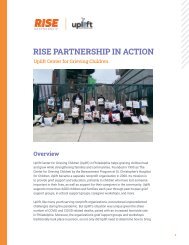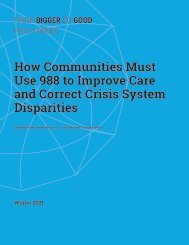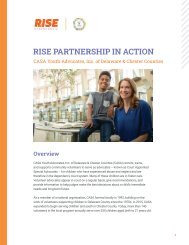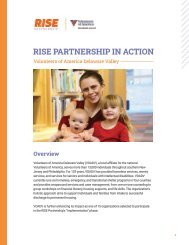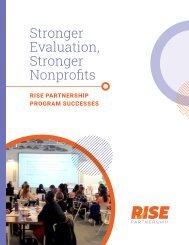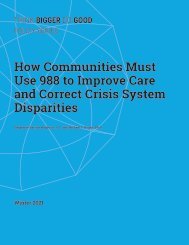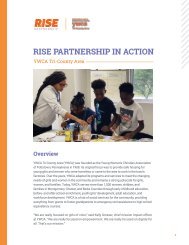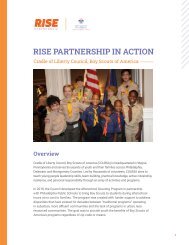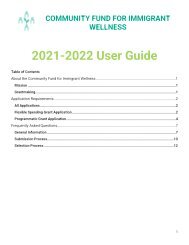Redesigning_Federal_Health_Insurance_Policies_to_Promote_Children’s_Mental_Health
You also want an ePaper? Increase the reach of your titles
YUMPU automatically turns print PDFs into web optimized ePapers that Google loves.
THINK BIGGER DO GOOD<br />
POLICY SERIES<br />
<strong>Redesigning</strong> <strong>Federal</strong><br />
<strong>Health</strong> <strong>Insurance</strong><br />
<strong>Policies</strong> <strong>to</strong> <strong>Promote</strong><br />
<strong>Children’s</strong> <strong>Mental</strong><br />
<strong>Health</strong><br />
Kimberly Hoagwood, Ph.D.<br />
Cathy and Stephen Graham Professor and Vice Chair for Research,<br />
New York University & Vice Chair for Research, Department of<br />
Child and Adolescent Psychiatry, NYU School of<br />
Medicine, Langone <strong>Health</strong><br />
Kelly Kelleher, M.D., M.P.H.<br />
Direc<strong>to</strong>r, Center for Innovation in Pediatric Practice<br />
& Vice President, Community and <strong>Health</strong> Services Research,<br />
The Research Institute at Nationwide <strong>Children’s</strong> Hospital<br />
Michael Hogan, Ph.D.<br />
Principal, Hogan <strong>Health</strong> Solutions<br />
Fall 2018
<strong>Redesigning</strong> <strong>Federal</strong> <strong>Health</strong> Behavioral <strong>Insurance</strong> <strong>Health</strong> <strong>Policies</strong> and the <strong>to</strong> Individual <strong>Promote</strong> <strong>Health</strong> <strong>Children’s</strong> <strong>Insurance</strong> <strong>Mental</strong> Market <strong>Health</strong>
Dear Reader,<br />
Now is a time of change in health and human services policy. Many of the changes could have profound<br />
implications for behavioral health. This paper is one in a series of papers proposing solution-oriented<br />
behavioral health policies.<br />
The past decade has been a time of steady advances in behavioral health policy. For example, we have<br />
met many of the objectives related <strong>to</strong> expanding health insurance coverage for people with behavioral<br />
health conditions. Coverage is now expected <strong>to</strong> be on a par with that available <strong>to</strong> individuals with any<br />
other health conditions, although parity implementation has encountered roadblocks. Coverage of evidencebased<br />
treatments has expanded with insurance, but not all of these services are covered by traditional<br />
insurance, necessitating other sources of funding, such as from block grants.<br />
Much has improved; much remains <strong>to</strong> be accomplished.<br />
As funders, The Thomas Scattergood Behavioral <strong>Health</strong> Foundation and Peg’s Foundation believe that<br />
now more than ever philanthropic support in the area of policy is critical <strong>to</strong> improving health outcomes<br />
for all. We ask that you share this paper and the others in the series with your programmatic partners,<br />
local, state, and federal decision makers, advocacy organizations, and voters.<br />
We believe that these papers analyze important issues in behavioral health policy, can inform policymaking,<br />
and improve health outcomes. In the back of the paper, there are suggested ways of how one<br />
can use the paper <strong>to</strong> further share these solution-oriented ideas and advocate for change. We hope these<br />
papers help <strong>to</strong> extend progress and avoid losing ground at a time of change in policy.<br />
Sincerely,<br />
Joseph Pyle, M.A.<br />
President<br />
Scattergood Foundation<br />
Founding Partner of Series<br />
Rick Kellar, M.B.A.<br />
President<br />
Peg’s Foundation<br />
Founding Partner of Series<br />
Howard Goldman, M.D., P.h.D.<br />
Series Edi<strong>to</strong>r
We would like <strong>to</strong> acknowledge the following individuals for their participation in<br />
the convening and the ongoing process that led <strong>to</strong> the conceptualization of the<br />
papers in this series.<br />
Colleen Barry, Ph.D., M.P.P.<br />
Bloomberg School of Public <strong>Health</strong> at<br />
John Hopkins University<br />
Pamela Greenberg, M.P.P.<br />
Association for Behavioral <strong>Health</strong><br />
and Wellness<br />
Sandra Newman, Ph.D.<br />
John Hopkins Bloomberg School of<br />
Public <strong>Health</strong><br />
Cynthia Baum-Baicker, Ph.D.<br />
Thomas Scattergood Behavioral<br />
<strong>Health</strong> Foundation<br />
Lisa Dixon, M.D., M.P.H.<br />
Columbia University College of<br />
Physicians and Surgeons,<br />
New York State Psychiatric Institute<br />
Sara E. Dugan, Pharm.D., B.C.P.P, B.C.P.S<br />
Northeast Ohio Medical University<br />
Arthur Evans, Ph.D.<br />
American Psychological Association<br />
Alyson Ferguson, M.P.H.<br />
Thomas Scattergood Behavioral<br />
<strong>Health</strong> Foundation<br />
Richard Frank, Ph.D.<br />
Harvard Medical School<br />
Rachel Garfield, Ph.D.<br />
Kaiser Family Foundation<br />
Aaron Glickman, B.A.<br />
Perelman School of Medicine,<br />
University of Pennsylvania<br />
Howard Goldman, M.D., Ph.D.<br />
University of Maryland School of Medicine<br />
Kimberly Hoagwood, Ph.D.<br />
New York University School of Medicine<br />
Michael Hogan, Ph.D.<br />
Case Western Reserve University<br />
School of Medicine<br />
Chuck Ingoglia, M.S.W.<br />
National Council for Behavioral <strong>Health</strong><br />
Sarah Jones, M.D. Candidate<br />
Thomas Scattergood Behavioral<br />
<strong>Health</strong> Foundation<br />
Rick Kellar, M.B.A.<br />
Peg’s Foundation<br />
Jennifer Mathis, J.D.<br />
Bazelon Center for <strong>Mental</strong> <strong>Health</strong> Law<br />
Amanda Mauri, M.P.H.<br />
Thomas Scattergood Behavioral<br />
<strong>Health</strong> Foundation<br />
Brian McGregor, Ph.D.<br />
Satcher <strong>Health</strong> Leadership Institute at<br />
Morehouse School of Medicine<br />
Erik Messamore, M.D., Ph.D<br />
Northeast Ohio Medical Univerisity<br />
Mark Munetz, M.D.<br />
Northeast Ohio Medical University<br />
Joe Pyle, M.A.<br />
Thomas Scattergood Behavioral<br />
<strong>Health</strong> Foundation<br />
Lloyd Sederer, M.D.<br />
New York State Office of <strong>Mental</strong> <strong>Health</strong>,<br />
Mailman School of Public <strong>Health</strong> at<br />
Columbia University<br />
Dominic Sisti, Ph.D.<br />
Scattergood Program for Applied Ethics<br />
in Behavioral <strong>Health</strong> Care<br />
Perelman School of Medicine,<br />
University of Pennsylvania<br />
Andrew Sperling, J.D.<br />
National Alliance for <strong>Mental</strong> Illness<br />
Hyong Un, M.D.<br />
Aetna<br />
Kate Williams, J.D.<br />
Thomas Scattergood Behavioral<br />
<strong>Health</strong> Foundation<br />
Glenda Wrenn, M.D., M.S.H.P.<br />
Satcher <strong>Health</strong> Leadership Institute at<br />
Morehouse School of Medicine<br />
Julia Zur, Ph.D.<br />
Kaiser Family Foundation<br />
<strong>Redesigning</strong> <strong>Federal</strong> <strong>Health</strong> <strong>Insurance</strong> <strong>Policies</strong> <strong>to</strong> <strong>Promote</strong> <strong>Children’s</strong> <strong>Mental</strong> <strong>Health</strong><br />
4
Titles in the Paper Series<br />
Edi<strong>to</strong>rs Howard Goldman, M.D., Ph.D. and Constance Gartner, M.S.W.<br />
America’s Opioid Epidemic Lloyd Sederer, M.D.<br />
Behavioral <strong>Health</strong> and the Individual <strong>Health</strong> <strong>Insurance</strong> Market: Preserving Key<br />
Elements of Reform Richard Frank, Ph.D. and Sherry Glied, Ph.D., M.A.<br />
Bringing Treatment Parity <strong>to</strong> Jail Inmates with Schizophrenia Mark R. Munetz,<br />
M.D., Erik Messamore, M.D., Ph.D, and Sara E. Dugan, Pharm.D., B.C.P.P, B.C.P.S<br />
Coordinated Specialty Care for First-Episode Psychosis: An Example of Financing<br />
for Specialty Programs Lisa Dixon, M.D., M.P.H.<br />
Employing People with <strong>Mental</strong> Illness in the 21st Century: Labor Market Changes<br />
and Policy Challenges Richard Frank, Ph.D. and Sherry Glied, Ph.D., M.A.<br />
Fentanyl and the Evolving Opioid Epidemic: What Strategies Should Policymakers<br />
Consider? Colleen Barry, Ph.D., M.P.P.<br />
Improving Outcomes for People with Serious <strong>Mental</strong> Illness and Co-Occurring<br />
Substance Use Disorders in Contact with the Criminal Justice System Glenda<br />
Wrenn, M.D., M.S.H.P., Brian McGregor, Ph.D., and Mark Munetz, M.D.<br />
Medicaid’s Institutions for <strong>Mental</strong> Diseases (IMD) Exclusion Rule: A Policy Debate<br />
Jennifer Mathis, J.D., versus Dominic A. Sisti, Ph.D. and Aaron Glickman, B.A.<br />
Suicide Is a Significant <strong>Health</strong> Problem Michael Hogan, Ph.D.<br />
The Current Medicaid Policy Debate and Implications for Behavioral <strong>Health</strong>care in<br />
the United States Rachel Garfield, Ph.D., M.H.S. and Julia Zur, Ph.D.
<strong>Redesigning</strong> <strong>Federal</strong> <strong>Health</strong> <strong>Insurance</strong> <strong>Policies</strong> <strong>to</strong> <strong>Promote</strong> <strong>Children’s</strong> <strong>Mental</strong> <strong>Health</strong><br />
6
<strong>Redesigning</strong> <strong>Federal</strong><br />
<strong>Health</strong> <strong>Insurance</strong><br />
<strong>Policies</strong> <strong>to</strong> <strong>Promote</strong><br />
<strong>Children’s</strong> <strong>Mental</strong><br />
<strong>Health</strong><br />
Kimberly Hoagwood, Ph.D.<br />
Cathy and Stephen Graham Professor and Vice Chair for Research, New York University<br />
& Vice Chair for Research, Department of Child and Adolescent Psychiatry, NYU School of<br />
Medicine, Langone <strong>Health</strong><br />
Kelly Kelleher, M.D., M.P.H.<br />
Direc<strong>to</strong>r, Center for Innovation in Pediatric Practice & Vice President, Community and <strong>Health</strong> Services Research,<br />
The Research Institute at Nationwide <strong>Children’s</strong> Hospital<br />
Michael Hogan, Ph.D.<br />
Principal, Hogan <strong>Health</strong> Solutions
1<br />
The Problem: <strong>Policies</strong><br />
Address Deficits Rather<br />
than <strong>Promote</strong> <strong>Health</strong>y<br />
Development<br />
Effective interventions <strong>to</strong> enhance child and adolescent mental health can be focused<br />
on rehabilitation, treatment of acute conditions, prevention of new conditions,<br />
or promotion of mental well-being. Although a growing body of science suggests<br />
that the most cost-effective and moral solutions focus on early promotion and<br />
prevention, the U.S. federal agencies that spend the most on child and adolescent<br />
mental health continue <strong>to</strong> focus their payments on rehabilitative and treatment<br />
services. Specifically, the federal Medicaid and <strong>Children’s</strong> <strong>Health</strong> <strong>Insurance</strong> Program<br />
(CHIP) programs are the dominant revenue sources for behavioral health services <strong>to</strong><br />
children and adolescents in the U.S. Although there are other funding streams that<br />
cover early education and developmental services for children (e.g., Maternal and<br />
Child <strong>Health</strong> Services Block Grant [Title V, Social Security Act]; Head Start early intervention<br />
services [via the Individuals with Disabilities Education Act, Part C]); Child<br />
Care Development Block Grant; and the Maternal, Infant, and Early Childhood Home<br />
Visiting Program), Medicaid and CHIP cover almost half of all children with special<br />
healthcare needs. Medicaid and its Early Prevention, Screening, Diagnosis and Treatment<br />
Program (EPSDT) and CHIP offer health and behavioral healthcare coverage for<br />
children whose parents are unable <strong>to</strong> afford private health insurance. Although these<br />
programs are designed nationally, they are administered at the state level.<br />
Medicaid alone covers a <strong>to</strong>tal of 70 million individuals, including a large share of vulnerable<br />
populations—32% of children (44.2 million) and 46% of pregnant women—and<br />
has an annual cost of $475 billion <strong>to</strong> federal and state taxpayers. 1 However, because<br />
Medicaid’s EPSDT and CHIP emerged from adult-oriented insurance models, they are<br />
primarily oriented <strong>to</strong>ward providing services when problems arise, rather than supporting<br />
the conditions for children’s healthy development. Access <strong>to</strong> most services<br />
under Medicaid requires that a licensed provider, in an approved or licensed site,<br />
assign a diagnosis for an illness <strong>to</strong> an individual—meaning that <strong>to</strong> access behavioral<br />
health services, a mental health problem has <strong>to</strong> have already developed.<br />
<strong>Redesigning</strong> <strong>Federal</strong> <strong>Health</strong> <strong>Insurance</strong> <strong>Policies</strong> <strong>to</strong> <strong>Promote</strong> <strong>Children’s</strong> <strong>Mental</strong> <strong>Health</strong><br />
8
Children, however, are not small adults. Neurodevelopmental studies, animal models,<br />
and studies of brain plasticity in infancy have established how important early<br />
childhood is for forming capacities for lifelong development, 2,3,4 marking this as a<br />
period of both great vulnerability and great opportunity. 5 The neural connections<br />
that form the building blocks of brain development begin before birth and continue<br />
in<strong>to</strong> early adulthood. Therefore, early interventions can have profound and long-lasting<br />
effects, and a wide range of interventions addressing neuro-regulation and social<br />
relationships are effective. 6,7,8 Just under half of U.S. children experience at least<br />
one adverse childhood event (ACE), and one in ten experiences three or more; these<br />
negative events place them at high risk for later negative health and mental health<br />
outcomes. Although a strong body of evidence traces the impact of ACEs on lifelong<br />
development, 9,10,11 an equally strong body of evidence exists about effective prevention<br />
and early intervention services <strong>to</strong> mitigate these negative outcomes. 12<br />
Therefore, the opportunity is <strong>to</strong> redesign Medicaid, EPSDT, and CHIP so that they<br />
optimize children’s development and functioning and promote the capacity for<br />
lifelong health and quality of life. We recognize that the changes we suggest will not<br />
affect all U.S. children, because these policies cover only a portion of the nation’s<br />
child population—those in families with lower incomes. Nevertheless, making these<br />
changes would set a precedent. We also recognize that decisions about modifications<br />
are made at both federal and state levels and that there is considerable latitude<br />
for states <strong>to</strong> adjust coverage. In this paper, we focus primarily on policy levers<br />
where federal guidance <strong>to</strong> states will promote coverage likely <strong>to</strong> optimize children’s<br />
healthy development. A thoughtful redesign will attend <strong>to</strong> the unique developmental<br />
issues of children, including the systems in which they live, learn, and seek services<br />
(i.e., home, school, neighborhood, and primary healthcare). We argue for a redesign<br />
<strong>to</strong> explicitly address four issues with greater relevance <strong>to</strong> children’s development:<br />
periodicity (i.e., the developmental continuum, requiring ongoing assessment of<br />
functioning); provider capacity (requiring expansion of service providers <strong>to</strong> include<br />
skilled nonprofessional providers and increased training); place or setting expansion<br />
<strong>to</strong> offer continuous, coordinated, responsive, and flexible coverage across a range of<br />
locations; and payment reform <strong>to</strong> ensure that services are adequately reimbursed in<br />
different contexts and <strong>to</strong> promote investments in prevention and early intervention<br />
programming. We conclude with specific recommendations.
2<br />
The Need for Policy<br />
Redesign: Four Key<br />
Areas<br />
Periodicity<br />
An orienting feature that distinguishes children from adults is their developmental<br />
plasticity. To promote and optimize children’s functioning, ongoing assessment and<br />
moni<strong>to</strong>ring of core functional markers is needed <strong>to</strong> guide the rapid deployment of interventions—as<br />
conditions develop—for children with high-risk profiles (e.g., three or<br />
more ACEs). Therefore, measurement and moni<strong>to</strong>ring of children’s functioning over<br />
time must be frequent (periodic) and coordinated across systems and must take in<strong>to</strong><br />
account developmental change, proxy reports, and temporal stability of measures as<br />
complicating fac<strong>to</strong>rs in measurement psychometrics.<br />
What Is Missing?<br />
The current design of Medicaid’s EPSDT and CHIP falls short. The Center for Medicaid<br />
and Medicaid Services (CMS) 2013 policy guidance 13 on the assessment of childhood<br />
functioning recommends using the periodicity schedules set by Bright Futures<br />
and standardized assessments (e.g., Ages and Stages Questionnaire and Pediatric<br />
Symp<strong>to</strong>ms Checklist) in general medical settings for children. These are necessary<br />
but insufficient steps. These nonspecific recommendations are implemented poorly<br />
in most settings. First, state EPSDT programs have noted consistent shortcomings in<br />
the actual delivery of developmental and behavioral screening and treatment in primary<br />
care and general medical settings. Second, Medicaid and CHIP reimbursement<br />
policies exclude payment for behavioral health services provided in numerous other<br />
settings that are not licensed or certified as specialty sites, where high-risk children<br />
are often found, such as homes, general classrooms, juvenile justice settings, foster<br />
care homes, and youth development programs. Third, current measurement standards<br />
are not tied <strong>to</strong> key child functioning goals, such as kindergarten readiness,<br />
third-grade literacy, or high school graduation. This is because pediatric measures<br />
for state reporting are focused narrowly on follow-up after hospitalization or diagnosis-specific<br />
services (e.g., for ADHD), not on functioning. The implication for providers<br />
and payers: that the process of developmental and behavioral screening is more<br />
important than outcome.<br />
<strong>Redesigning</strong> <strong>Federal</strong> <strong>Health</strong> <strong>Insurance</strong> <strong>Policies</strong> <strong>to</strong> <strong>Promote</strong> <strong>Children’s</strong> <strong>Mental</strong> <strong>Health</strong><br />
10
Provider Capacity<br />
There are substantial workforce shortages and a likely misallocation of providers<br />
who care for children’s behavioral health. This includes shortages of pediatricians,<br />
case managers, special education teachers, social workers, psychiatrists, and behavioral<br />
healthcare workers, particularly in rural areas. 14,15,16,17,18 Coupled with these<br />
workforce shortages are issues around lack of training—especially in developmental<br />
assessment and psychosocial interventions—for general healthcare providers,<br />
teachers, and other frontline professionals who work with children. Training deficits<br />
are most pronounced in knowledge about basic developmental competencies,<br />
recognition of behavioral health issues, and evidence about effective early interventions.<br />
19,20 There are <strong>to</strong>o few specialists, and the generalists do not understand the<br />
emerging science on mental health promotion, prevention, and early intervention<br />
that could alter the trajec<strong>to</strong>ry of many children.<br />
What Is Missing?<br />
Policy guidance is absent <strong>to</strong> support widespread workforce training on the use of<br />
effective prevention and early intervention programs. Also absent is guidance promoting<br />
expansion of the behavioral health workforce <strong>to</strong> include family peer support,<br />
youth peer support, and telemedicine. These are low-cost, acceptable, and effective<br />
alternative services. Medicaid guidance on funding sources for family and youth<br />
peer support services and telemental health for children is inconsistent and poorly<br />
unders<strong>to</strong>od or applied. The most recent federal guidance on peer support 21 provides<br />
only general guidelines on scope of and access <strong>to</strong> peer support services. Some states<br />
are using Medicaid administrative matches <strong>to</strong> pay for these services. Similarly,<br />
federal guidance continues <strong>to</strong> support low reimbursement rates for telemedicine,<br />
compared with reimbursement for face-<strong>to</strong>-face services.
Place<br />
Promoting children’s behavioral health and resilience is most effective when<br />
services can be provided in places where young children develop that include<br />
nontraditional healthcare settings, such as homes, schools, and other natural<br />
contexts (e.g., childcare settings and faith-based settings). This is because many<br />
effective interventions focus on improving skills of parents and other primary<br />
caregivers (e.g., early education staff). It also means that providers (i.e., case<br />
managers, early learning specialists, and healthcare specialists) need <strong>to</strong> be trained<br />
in how <strong>to</strong> provide services within these nontraditional settings. However, both<br />
Medicaid’s EPSDT and CHIP favor delivery of services in more traditional settings<br />
(i.e., outpatient and hospital-based settings).<br />
What Is Missing?<br />
The provision of services in nontraditional mental health service settings, such<br />
as in the home and in childcare settings, is covered under Medicaid’s Home and<br />
Community-Based Services Waiver program, which also includes the provision of<br />
intensive in-home services, but these services are largely case management for<br />
already identified “patients,” and coverage in schools is limited. The covered services<br />
do not currently include prevention or promotion services.<br />
<strong>Redesigning</strong> <strong>Federal</strong> <strong>Health</strong> <strong>Insurance</strong> <strong>Policies</strong> <strong>to</strong> <strong>Promote</strong> <strong>Children’s</strong> <strong>Mental</strong> <strong>Health</strong><br />
12
Payment<br />
Paying for children’s prevention and health promotion services requires thinking differently about<br />
return on investment, the balance of long-term savings vs. short term gains, and the availability of<br />
appropriate codes with which <strong>to</strong> support these services (i.e., nonmedical necessity).<br />
What Is Missing?<br />
There is no code enabling reimbursement for moni<strong>to</strong>ring or tracking of pediatric referrals <strong>to</strong><br />
behavioral health services, thus making it unlikely that follow-through will be tracked and measured<br />
and that children will receive follow-up care. In addition, the current design incentivizes shortterm<br />
contracts with managed care organizations, thus making long-term investments, which<br />
could include prevention and early intervention programs, difficult <strong>to</strong> secure. The payment models<br />
that exist are largely based on fee-for-service configurations. To address children’s developmental<br />
functioning, however, and <strong>to</strong> ensure that no child is missed, population-based payments linked<br />
<strong>to</strong> full accountability need <strong>to</strong> be integrated in<strong>to</strong> policies. This could include pediatric accountable<br />
care organizations (ACOs) and value-based purchasing mechanisms, discussed below in<br />
recommendations.<br />
There is no code enabling reimbursement for moni<strong>to</strong>ring or<br />
tracking of pediatric referrals <strong>to</strong> behavioral health services,<br />
thus making it unlikely that follow-through will be tracked<br />
and measured and that children will receive follow-up care.
3<br />
Action Items for<br />
Policymakers and<br />
Advocates<br />
1. Develop and Implement Measures That Assess<br />
<strong>Children’s</strong> Development (Periodicity)<br />
An important step is <strong>to</strong> develop measures that allow for frequent moni<strong>to</strong>ring of<br />
children’s development and functioning—measures that capture childhood’s incremental<br />
changes, with explicit attention <strong>to</strong> modifiable community and neighborhood<br />
fac<strong>to</strong>rs 22,23,24 that have an impact on children’s health and development. Although<br />
CMS’s 2016 overhaul of Medicaid managed care 25 requires states <strong>to</strong> collect a standard<br />
set of encounter data, these data do not include periodic measurement of children’s<br />
development. States are required <strong>to</strong> report on <strong>Health</strong>care Effectiveness Data and<br />
Information Set (HEDIS) measures, but measures for children are focused largely on<br />
hospitalization rates or on specific diagnoses (e.g., ADHD and depression). The National<br />
Academy of Science, Engineering, and Medicine (NASEM) recommends an alternative<br />
approach: the Vital Signs: Core Metrics for <strong>Health</strong> and <strong>Health</strong> Care Progress<br />
report identifies 15 domains for capturing a range of health outcomes; however, most<br />
of these domains are focused on adults, not children. 26 A recent initiative, organized<br />
by NASEM’s Forum on Promoting <strong>Children’s</strong> Cognitive, Affective, and Behavioral<br />
<strong>Health</strong>, is identifying developmentally responsive functional measures for children<br />
<strong>to</strong> parallel or complement the broader Vital Signs work. The pediatric measures will<br />
capture cross-system issues, especially important for children; account for continuity<br />
of care and social determinants of health that comprise children’s environments;<br />
and include community and neighborhood measures. 22,23,27<br />
2. Expand the Range of Providers Whose Services<br />
Are Reimbursable<br />
There are limited payment options under current mainstream federal policies for services<br />
delivered by professionals other than licensed medical or health providers. <strong>Federal</strong><br />
guidance is needed <strong>to</strong> clarify the competencies—not professional degrees—needed<br />
by a wide range of professionals (e.g., early childhood paraprofessionals and parent<br />
and youth peer support providers) who have the potential <strong>to</strong> provide evidence-based,<br />
appropriate early intervention and prevention services. For example, only about a<br />
<strong>Redesigning</strong> <strong>Federal</strong> <strong>Health</strong> <strong>Insurance</strong> <strong>Policies</strong> <strong>to</strong> <strong>Promote</strong> <strong>Children’s</strong> <strong>Mental</strong> <strong>Health</strong><br />
14
third of states currently use Medicaid funding for peer parent support services, 28<br />
although evidence for these programs, as well as a national certification process<br />
and pool of certified candidates, exists. And, although 34 states report that Medicaid<br />
covers an “early childhood mental health specialist,” no state covers services that<br />
aim <strong>to</strong> benefit an entire classroom or group of children through consultation or group<br />
training activities. Opportunities also exist <strong>to</strong> expand provider capacity by increasing<br />
federal reimbursement for telemedicine behavioral health coverage and for states <strong>to</strong><br />
expand their coverage of this service, which reaches rural areas where such services<br />
are critically needed; currently, the Medicaid telemedicine provider reimbursement<br />
rates are far below both Medicare and commercial insurance rates. 29<br />
Recent federal efforts <strong>to</strong> increase workforce capacity via evidence-based training<br />
and technical assistance do not cover early childhood prevention and intervention<br />
programming or providers. They need <strong>to</strong> do so. The Substance Abuse and <strong>Mental</strong><br />
<strong>Health</strong> Services Administration’s recent program announcements for regional <strong>Mental</strong><br />
<strong>Health</strong> Technology Transfer Centers 30 and Prevention <strong>Mental</strong> <strong>Health</strong> Technology<br />
Transfer Centers 31 represent a significant development. However, the announcements<br />
focus on “those with serious mental illness” and “provide training and technical<br />
assistance services <strong>to</strong> the substance abuse prevention field.” Neither of these<br />
efforts is likely <strong>to</strong> provide training and technical assistance <strong>to</strong> help establish early<br />
intervention programming needed for children and parents <strong>to</strong> remediate the effect<br />
of ACEs and prevent mental illnesses from developing. This is a missed opportunity.<br />
Some states are enacting statewide training initiatives <strong>to</strong> re<strong>to</strong>ol their current workforce,<br />
including New York State’s Evidence-Based Treatment and Dissemination<br />
Center and Minnesota’s Evidence-Based Practices initiative, both of which utilize<br />
the Managing and Adapting Practice system. 32 States are also addressing workforce<br />
shortages by creating credentialing processes <strong>to</strong> train and certify peer support<br />
providers, including parents and youth. 33,34,35,36,37 Family peer advocates (FPAs) are a<br />
group of providers whose work improves family engagement, access, and knowledge<br />
about quality. 38,39,40,41,42,43,44 A national training and certification program also exists<br />
for peer parent support providers in children’s mental health. 45 New York State has<br />
made a significant investment in family peer support, training and certifying nearly<br />
800 FPAs, and is expanding its training and certification efforts by using different<br />
models (e.g., train-the-trainer), 46 including launching online training modules, 47 in<br />
anticipation of the growing use of FPAs now that Medicaid reimburses for those<br />
services. <strong>Federal</strong> guidance is needed <strong>to</strong> help states expand reimbursable services by<br />
using nontraditional workforces, including family and youth peer support specialists.<br />
Telemedicine and digital services also counteract the effects of workforce shortages.
3. <strong>Promote</strong> “Place-Based” Services <strong>to</strong> Serve Children<br />
and Parents Where They Are<br />
Coverage of services needs <strong>to</strong> be expanded <strong>to</strong> include services delivered where<br />
children spend most of their time (e.g., homes, schools, and communities). This<br />
should include support for evidence-based parenting programs, early intervention<br />
skills training, and school readiness (e.g., early literacy and reading). These kinds of<br />
services do not fit within the traditional model because they are delivered outside<br />
of specialty mental health clinics and do no necessitate a mental health diagnosis.<br />
NASEM’s recently formed Collaborative on <strong>Health</strong>y Parenting in Primary Care has<br />
identified specific policy opportunities for delivering evidence-based parent support<br />
programs and family-focused interventions (e.g., Triple P and Incredible Years) in<br />
primary care, 48 but these are not reimbursable under Medicaid or CHIP. In addition,<br />
the U.S. Preventive Services Task Force recently recommended both public and private<br />
insurance coverage for family-focused interventions as a preventive measure.<br />
Embedding reimbursement codes for these kinds of services would facilitate children’s<br />
healthy development. Current Medicaid regulations do not overtly promote<br />
parent enrollment in evidence-based parent training programs; only 12 states report<br />
that Medicaid pays for parenting programs (and only two of these states, Michigan<br />
and Oregon, require providers <strong>to</strong> use an evidenced-based parenting program); 37<br />
states (76%) report that they do not cover these services, 49 despite evidence of their<br />
effectiveness 6,50,51 as well as their significant cost-benefit savings. 52 Finally, current<br />
Medicaid policy design sometimes promotes discontinuous coverage and disruption<br />
of services for many of the highest-risk children when there are minor changes in<br />
residence, foster care transitions, and eligibility changes due <strong>to</strong> disability.<br />
Another potential avenue for expanding place-based coverage is through the Home<br />
and Community-Based Services (HCBS) Waiver program, authorized by the Social<br />
Security Act. This program allows for the provision of standard medical and nonmedical<br />
services in the home or community. The target of HCBS services is individuals<br />
with established diagnoses and usually those who already have tangible<br />
impairments. As such, this “flexible” model is not able <strong>to</strong> provide developmental<br />
interventions for children who are high risk of not flourishing (i.e., who have multiple<br />
ACEs), because these children are not yet diagnosed or disabled. HCBS services<br />
have begun <strong>to</strong> revolutionize care for children with autism spectrum disorders, with<br />
covered behavioral interventions aimed at improving functioning. Such an approach<br />
would be very useful for children who have experienced multiple ACEs. This would<br />
require redefining eligibility, perhaps by limiting access <strong>to</strong> children with high ACE<br />
scores (e.g., three or more), linking the services <strong>to</strong> full-service pediatric practices,<br />
<strong>Redesigning</strong> <strong>Federal</strong> <strong>Health</strong> <strong>Insurance</strong> <strong>Policies</strong> <strong>to</strong> <strong>Promote</strong> <strong>Children’s</strong> <strong>Mental</strong> <strong>Health</strong><br />
16
and defining the scope of intervention (e.g., number and type of sessions). <strong>Federal</strong><br />
guidance could consider piloting, via a limited waiver opportunity paired with a robust<br />
evaluation, HCBS services coordinated by full-service pediatric practices (using<br />
collaborative care bundled payments) for young children at high risk of developing a<br />
behavioral health diagnosis. The services should be focused on evidence-based interventions<br />
and circumscribed as appropriate in terms of amount, scope, and duration.<br />
4. Further Develop Innovative Payment Models and Tools <strong>to</strong><br />
<strong>Promote</strong> Prevention and Early Intervention Programs<br />
More sophisticated, complex, creative, and sustainable financing mechanisms are<br />
needed <strong>to</strong> fund early prevention and intervention programming. Some states are<br />
finding innovative ways, in the absence of federal guidance, <strong>to</strong> invest in the early<br />
years. Oregon’s “At-Risk Codes” allow payments for early intervention <strong>to</strong> reduce the<br />
development of serious mental health conditions later, 53 and New York State’s “First<br />
1,000 Days of Medicaid” recognizes that a child’s first three years are the most crucial<br />
years of development. 54<br />
New Payment Models<br />
Several CMS efforts have attempted <strong>to</strong> address the development of new payment<br />
models, including CMS’s 2017 Request for Information on Pediatric Alternative<br />
Payment Model Opportunities, 55 which sought input on the design of alternative<br />
payment models <strong>to</strong> improve the health of children and youth covered by Medicaid<br />
and CHIP and focused on concepts that encourage pediatric providers <strong>to</strong> collaborate<br />
with health-related social service providers at the state and local levels. However, no<br />
further follow-up or request for proposals (RFP) has been issued (as of July 2018). CMS<br />
also funded 31 demonstration projects under the Accountable <strong>Health</strong> Communities<br />
Model and developed a <strong>Health</strong>-Related Social Needs Screening Tool. 56 Opportunities<br />
exist <strong>to</strong> provide additional technical assistance <strong>to</strong> communities <strong>to</strong> further develop<br />
these needed models, with a focus on pediatric ACOs and expanding value-based purchasing<br />
mechanisms <strong>to</strong> include pediatric health and behavioral health. To date (July<br />
2018), no RFPs or further federal policy regulations or policy guidance exist <strong>to</strong> support<br />
broader implementation of these alternative financing models/mechanisms.
Pediatric ACOs<br />
Pediatric ACOs began nearly two decades ago. However, utilization of this model is<br />
not widespread and is exclusively affiliated with large hospital systems. As such,<br />
the variability across models—due <strong>to</strong> state-<strong>to</strong>-state differences in Medicaid and lack<br />
of federal guidance on structure and financing—has made existing pediatric ACO<br />
models nationwide difficult <strong>to</strong> compare, align, or regulate for best practices. 57 Two<br />
recent evaluations of pediatric ACOs, one of early adopters and another profiling<br />
hospital-based models, found a need for more complex financial models <strong>to</strong> account<br />
for the long-term investment and short-term savings. Further, the cost-savings<br />
goals tend <strong>to</strong> take precedence over measurement of quality, and there is a need for<br />
development of ACO quality measures. 57,58<br />
One example of a pediatric ACO model is Nationwide <strong>Children’s</strong> Hospital Partners<br />
for Kids (PFK), one of the oldest pediatric ACOs (founded in 1994) and a full-risk,<br />
population-based model that receives a Medicaid per-member per-month age- and<br />
sex-adjusted payment. PFK has demonstrated lower costs than fee-for-service or<br />
managed care organizations. Importantly, this slowing in cost growth was achieved<br />
without losses in overall quality or outcomes of care. 59 In addition, PFK’s care<br />
coordination reduced inpatient and emergency department utilization. 60<br />
Value-based purchasing<br />
In the past decade, many states have undertaken significant efforts <strong>to</strong> overhaul<br />
their Medicaid plans, 61,62 with reforms aimed at moving away from fee-for-service<br />
<strong>to</strong>ward increasing the value of the care they are providing. However, these efforts<br />
are happening in the absence of federal guidance, leading <strong>to</strong> uncertainty and<br />
inefficiencies. These include integrating primary and behavioral healthcare<br />
and replacing fee-for-service payments with reimbursements based on clients’<br />
attainment of health outcomes. 63,64 Two-thirds of children and youth covered by<br />
Medicaid and CHIP are now in managed care. 65<br />
Examples of state innovations include Oregon, which has created coordinated care<br />
organizations that are locally governed <strong>to</strong> address community needs on a single<br />
global budget, and New York State, which is implementing the Delivery System<br />
Reform Incentive Payment program and Performing Provider Systems <strong>to</strong> restructure<br />
Medicaid <strong>to</strong> reduce avoidable hospital use by 25% over five years. However, few<br />
children are hospitalized, and this focus in New York effectively excludes pediatric<br />
services. 66 Minnesota is piloting Certified Community Behavioral <strong>Health</strong> Centers and<br />
<strong>Health</strong> Home initiatives <strong>to</strong> coordinate care across settings and providers. 67 These<br />
state innovations are using more complex financial models <strong>to</strong> try <strong>to</strong> provide more<br />
flexible services, but they are not primarily targeted at children or at promoting<br />
children’s healthy development. This needs <strong>to</strong> change.<br />
<strong>Redesigning</strong> <strong>Federal</strong> <strong>Health</strong> <strong>Insurance</strong> <strong>Policies</strong> <strong>to</strong> <strong>Promote</strong> <strong>Children’s</strong> <strong>Mental</strong> <strong>Health</strong><br />
18
Return on Investment <strong>to</strong>ols<br />
States would also benefit from the development of <strong>to</strong>ols that allow them <strong>to</strong> calculate<br />
their return on investment (ROI) in early prevention and intervention programming.<br />
A recently published Commonwealth Fund “return-on-investment calcula<strong>to</strong>r”<br />
(Assessing Risks and Rewards of Integrating Social Services with <strong>Health</strong> Care)<br />
enables policymakers <strong>to</strong> weigh the value of partnerships/investments in social<br />
services that are likely <strong>to</strong> improve medical outcomes. 68 An adaptation of this <strong>to</strong>ol<br />
for investments in early prevention and intervention programming for children<br />
could provide state policymakers with data regarding their investments in these<br />
prevention and early intervention programs. An important caveat, however, is<br />
that it is unethical <strong>to</strong> hinge treatment on purely financial calculations. ROI <strong>to</strong>ols<br />
for prevention are not required for other health conditions (e.g., cancer and heart<br />
disease). Nevertheless, it would be useful for planning purposes <strong>to</strong> know probable<br />
ROIs for prevention programs for children. ROI analyses can be a useful <strong>to</strong>ol <strong>to</strong><br />
encourage expanded coverage by states. For example, since the late 1990s, the<br />
Washing<strong>to</strong>n State legislature has directed the Washing<strong>to</strong>n State Institute for<br />
Public Policy (WSIPP) <strong>to</strong> calculate the ROI <strong>to</strong> taxpayers from a variety of education,<br />
prevention, and intervention programs and policies. Today, WSIPP provides ROI data<br />
for an extensive range of programs and policies <strong>to</strong> guide decision making at the<br />
state level. 52
4 Conclusions<br />
Mainstream federal policies that address children’s health needs—Medicaid, including<br />
EPSDT, and CHIP—are not designed <strong>to</strong> promote healthy development or <strong>to</strong><br />
address the unique needs of children. We call for a redesign of these programs <strong>to</strong><br />
include development of billing codes and payment options <strong>to</strong> enable frequent moni<strong>to</strong>ring<br />
of children’s development (periodicity); training, technical assistance, and<br />
coverage of a range of credentialed, nontraditional providers; expansion of covered<br />
settings; and adoption of payment models at a systems level <strong>to</strong> create a sustainable<br />
structure. Supporting children necessitates equal attention <strong>to</strong> supporting—even<br />
nurturing—their families and communities <strong>to</strong> create the conditions for positive development<br />
and life-long functioning. <strong>Federal</strong> health policy must keep pace with the<br />
scientific evidence on what is known <strong>to</strong> create the conditions for future generations<br />
of children <strong>to</strong> thrive.<br />
<strong>Redesigning</strong> <strong>Federal</strong> <strong>Health</strong> <strong>Insurance</strong> <strong>Policies</strong> <strong>to</strong> <strong>Promote</strong> <strong>Children’s</strong> <strong>Mental</strong> <strong>Health</strong><br />
20
References<br />
1 / Medicaid’s Role for Children with Special <strong>Health</strong> Care<br />
Needs: A Look at Eligibility, Services, and Spending.<br />
Menlo Park, CA, Kaiser Family Foundation, 2018.<br />
2 / Hoffman MT: The science of early childhood development—closing<br />
the gap between what we know and<br />
what we do. J Dev Behav Pediatr 29:253–261, 2008.<br />
3 / Tierney AL, Nelson CA: Brain development and the<br />
role of experience in the early years. Zero Three<br />
30(2):9–13, 2009.<br />
4 / A Decade of Science Informing Policy: The S<strong>to</strong>ry of the<br />
National Scientific Council on the Developing Child.<br />
Cambridge, MA, Center on the Developing Child at<br />
Harvard University, 2014.<br />
5 / Giannopoulou I: Neurobiological inscriptions of psychological<br />
trauma during early childhood. Psychiatriki<br />
23(suppl 1):27–38, 2012.<br />
6 / O’Connell ME, Boat T, Warner KE (eds): Preventing<br />
<strong>Mental</strong>, Emotional, and Behavioral Disorders Among<br />
Young People: Progress and Possibilities. Washing<strong>to</strong>n,<br />
DC, National Academies Press, 2009.<br />
7 / National Academies of Sciences, Engineering, and<br />
Medicine: Implementing Evidence-Based Prevention<br />
by Communities <strong>to</strong> <strong>Promote</strong> Cognitive, Affective, and<br />
Behavioral <strong>Health</strong> in Children: Proceedings of a Workshop.<br />
Washing<strong>to</strong>n, DC, National Academies Press,<br />
2017.<br />
8 / Murray DW, Rosanbalm K, Chris<strong>to</strong>poulos C: Self-Regulation<br />
and Toxic Stress Report 4: Implications for<br />
Programs and Practice. OPRE Report 2015-97, Washing<strong>to</strong>n,<br />
DC, U.S. Department of <strong>Health</strong> and Human<br />
Services, Administration for Children and Families,<br />
Office of Planning, Research, and Evaluation, 2015.<br />
9 / Early Experiences Can Alter Gene Expression and<br />
Affect Long-Term Development. Working Paper 10.<br />
Cambridge, MA, Center on the Developing Child at<br />
Harvard University, National Scientific Council on the<br />
Developing Child, 2010.<br />
10 / Barch DM, Belden AC, Tillman R, et al.: Early childhood<br />
adverse experiences, inferior frontal gyrus connectivity,<br />
and the trajec<strong>to</strong>ry of externalizing psychopathology.<br />
J Am Acad Child Adolesc Psychiatry 57:183–190,<br />
2018.<br />
11 / Luby JL, Barch D, Whalen D, et al.: Association between<br />
early life adversity and risk for poor emotional and<br />
physical health in adolescence: a putative mechanistic<br />
neurodevelopmental pathway. JAMA Pediatr<br />
71:1168–1175, 2017.<br />
12 / Anderson, LM, Shinn C, Fullilove MT, et al.: The effectiveness<br />
of early childhood development programs: a<br />
systematic review. Am J Prev Med 24(3 suppl):32–46,<br />
2003.<br />
13 / EPSDT–A Guide for States: Coverage in the Medicaid<br />
Benefit for Children and Adolescents. Baltimore, MD,<br />
Center for Medicaid and Medicare Services, June 2014.<br />
<strong>Redesigning</strong> <strong>Federal</strong> <strong>Health</strong> <strong>Insurance</strong> <strong>Policies</strong> <strong>to</strong> <strong>Promote</strong> <strong>Children’s</strong> <strong>Mental</strong> <strong>Health</strong><br />
22
References<br />
14 / Report <strong>to</strong> Congress on the Nation’s Substance Abuse<br />
and <strong>Mental</strong> <strong>Health</strong> Workforce Issues. Rockville, MD,<br />
U.S. Department of <strong>Health</strong> and Human Services,<br />
Substance Abuse and <strong>Mental</strong> <strong>Health</strong> Services Administration,<br />
2013.<br />
20 / National Academies of Sciences, Engineering, and<br />
Medicine: Training the Future Child <strong>Health</strong> Care Workforce<br />
<strong>to</strong> Improve Behavioral <strong>Health</strong> Outcomes for Children,<br />
Youth, and Families: Proceedings of a Workshop.<br />
Washing<strong>to</strong>n, DC, National Academies Press, 2017.<br />
15 / American Academy of Pediatrics Committee on Pediatric<br />
Workforce: The use of telemedicine <strong>to</strong> address<br />
access and physician workforce shortages. Pediatrics<br />
136:201–209, 2015.<br />
16 / Hoge MA, Stuart GW, Morris J, et al.: <strong>Mental</strong> health and<br />
addiction workforce development: federal leadership<br />
is needed <strong>to</strong> address the growing crisis. <strong>Health</strong> Aff<br />
(Millwood) 32:2005–2012, 2013.<br />
17 / Hoge MA, Morris JA, Stuart GW, et al.: A national action<br />
plan for workforce development in behavioral health.<br />
Psychiatr Serv 60:883–887, 2009.<br />
18 / Stuart GW, Hoge MA, Morris JA, et al.: The Annapolis<br />
Coalition report on the behavioral health workforce<br />
needs of the United States: international implications.<br />
Int J Ment <strong>Health</strong>, 38:46–60, 2009.<br />
19 / Boat TF, Land ML, Leslie L, et al.: Workforce Development<br />
<strong>to</strong> Enhance the Cognitive, Affective, and Behavioral<br />
<strong>Health</strong> of Children and Youth: Opportunities and<br />
Barriers in Child <strong>Health</strong> Care Training. Discussion<br />
Paper. Washing<strong>to</strong>n, DC, National Academy of Medicine,<br />
2016.<br />
21 / Clarifying Guidance on Peer Support Services Policy.<br />
Baltimore, MD, Center for Medicaid and Medicare<br />
Services, May 1, 2013.<br />
22 / Pascoe JM, Wood DL, Duffee JH, et al.: Media<strong>to</strong>rs and<br />
adverse effects of child poverty in the United States.<br />
Pediatrics 137(4):e2016034016-0340, 2016.<br />
23 / Perrin JM, Boat TF, Kelleher KJ: The influence of<br />
health care policies on children’s health and development.<br />
Soc Policy Rep (Society for Research in Child<br />
Development) 29(4):3–14, 2016.<br />
24 / Institute of Medicine: Vital Signs: Core Metrics for<br />
<strong>Health</strong> and <strong>Health</strong> Care Progress. Washing<strong>to</strong>n, DC,<br />
National Academies Press, 2015.<br />
25 / Medicaid and <strong>Children’s</strong> <strong>Health</strong> <strong>Insurance</strong> Program<br />
(CHIP) programs; Medicaid managed care, CHIP delivered<br />
in managed care, and revisions related <strong>to</strong> third<br />
party liability. <strong>Federal</strong> Register 81:27498–27901, 2016.<br />
26 / Gardener W, Kelleher K: Core quality and outcome<br />
measures for pediatric health. JAMA Pediatr 171:827–<br />
828, 2017.
References<br />
27 / Hoagwood KE, Olin SS, Horwitz S, et al.: Scaling up<br />
evidence-based practices for children and families in<br />
New York State: <strong>to</strong>ward evidence-based policies on<br />
implementation for state mental health systems. J<br />
Clin Child Adolesc Psychol 43:145–157, 2014.<br />
35 / Kaufman L, Kuhn WB, Manser SS, et al.: Peer Specialist<br />
Training and Certification Programs: National<br />
Overview 2016. Austin, University of Texas at Austin,<br />
School of Social Work, Texas Institute for Excellence in<br />
<strong>Mental</strong> <strong>Health</strong>, 2017.<br />
28 / Medicaid Financing for Family and Youth Peer Support:<br />
A Scan of State Programs. Hamil<strong>to</strong>n, NJ, Center<br />
for <strong>Health</strong> Care Strategies, 2012.<br />
29 / Telehealth Medicaid and State Policy. Sacramen<strong>to</strong>, CA,<br />
Center for Connected <strong>Health</strong> Policy, 2018.<br />
36 / Family Peer Advocate Credential (FPA). Albany, Families<br />
Together in New York State, 2018.<br />
37 / Kids for Keeps: Strengthening Families <strong>to</strong> Raise<br />
<strong>Health</strong>y Children. Topeka, Kansas Keys for Networking,<br />
Inc., 2018.<br />
30 / <strong>Mental</strong> <strong>Health</strong> Technology Transfer Center Cooperative<br />
Agreements. Rockville, MD, U.S. Department of<br />
<strong>Health</strong> and Human Services, Substance Abuse and<br />
<strong>Mental</strong> <strong>Health</strong> Services Administration, 2018.<br />
38 / Jamison JM, Fourie E, Siper PM, et al.: Examining the<br />
efficacy of a family peer advocate model for black and<br />
Hispanic caregivers of children with autism spectrum<br />
disorder. J Autism Dev Disord 47:1314–1322, 2017.<br />
31 / Prevention Technology Transfer Center Cooperative<br />
Agreements. Rockville, MD, U.S. Department of <strong>Health</strong><br />
and Human Services, Substance Abuse and <strong>Mental</strong><br />
<strong>Health</strong> Services Administration, 2018.<br />
39 / Radigan M, Wang R, Chen Y, et al.: Youth and caregiver<br />
access <strong>to</strong> peer advocates and satisfaction with mental<br />
health services. Community Ment <strong>Health</strong> J 50:915–921,<br />
2014.<br />
32 / Managing and Adapting Practice (MAP). Satellite<br />
Beach, FL, PracticeWise, 2018.<br />
33 / Fisher EB, Boothroyd RI, Elstad EA, et al.: Peer support<br />
of complex health behaviors in prevention and disease<br />
management with special reference <strong>to</strong> diabetes:<br />
systematic reviews. Clin Diabetes Endocrinol 3:4, 2017.<br />
34 / Hoagwood KE, Cavaleri MA, Olin, SS, et al.: Family support<br />
in children’s mental health: a review and synthesis.<br />
Clin Child Family Psychol Rev 13:1–45, 2010.<br />
40 / Kutash K, Duchnowski AJ, Green AL, et al. Effectiveness<br />
of the Parent Connec<strong>to</strong>rs program: results from<br />
a randomized controlled trial. School Ment <strong>Health</strong><br />
5:192–208, 2013.<br />
41 / Kutash K, Duchnowski AJ, Green AL, et al. Supporting<br />
parents who have youth with emotional disturbances<br />
through a parent-<strong>to</strong>-parent support program: a proof of<br />
concept study using random assignment. Adm Policy<br />
Ment <strong>Health</strong> 38:412–427, 2011.<br />
<strong>Redesigning</strong> <strong>Federal</strong> <strong>Health</strong> <strong>Insurance</strong> <strong>Policies</strong> <strong>to</strong> <strong>Promote</strong> <strong>Children’s</strong> <strong>Mental</strong> <strong>Health</strong><br />
24
References<br />
42 / McKay MM, Gopalan G, Franco L, et al.: A collaboratively<br />
designed child mental health service model: multiple<br />
family groups for urban children with conduct<br />
difficulties. Res Soc Work Pract 21:664–674, 2011.<br />
49 / Smith S, Granja M, Ekono M, et al.: Using Medicaid<br />
<strong>to</strong> Help Young Children and Parents Access <strong>Mental</strong><br />
<strong>Health</strong> Services. New York, NY: National Center for<br />
Children in Poverty, 2017.<br />
43 / Olin SS, Hoagwood KE, Rodriguez J, et al.: The application<br />
of behavior change theory <strong>to</strong> family-based services:<br />
improving parent empowerment in children’s<br />
mental health. J Child Fam Stud 19:462–470, 2011.<br />
44 / Fristad MA, Verducci JS, Walters K, et al.: Impact of<br />
multifamily psychoeducational psychotherapy in<br />
treating children aged 8 <strong>to</strong> 12 years with mood disorders.<br />
Arch Gen Psychiatry 66:1013–1021, 2009.<br />
45 / National Certification for Parent Family Peers. Rockville,<br />
MD, National Federation of Families for <strong>Children’s</strong><br />
<strong>Mental</strong> <strong>Health</strong>, 2018.<br />
46 / Hoagwood KE, Olin SS, S<strong>to</strong>rfer-Isser A, et al.: Evaluation<br />
of a train-the-trainers model for family peer advocates<br />
in children’s mental health. J Child Fam Stud 27:1130–<br />
1136, 2018.<br />
47 / Kuppinger AD, Burger ST, Bur<strong>to</strong>n G, et al.: Training and<br />
credentialing the family peer advocate workforce in<br />
New York State. Poster presentation. Washing<strong>to</strong>n, D.C.,<br />
National Academies of Sciences, Engineering, and<br />
Medicine, Forum on Promoting <strong>Children’s</strong> Well-Being,<br />
2016.<br />
48 / Leslie LK, Mehus CJ, Hawkins JD, et al.: Primary health<br />
care: potential home for family-focused preventive<br />
interventions. Am J Prev Med 51(suppl 2):S106–S118,<br />
2016.<br />
50 / Shonkoff JP, Phillips DA (eds): From Neurons <strong>to</strong> Neighborhoods:<br />
The Science of Early Childhood Development.<br />
Washing<strong>to</strong>n, DC, National Academy Press, 2000.<br />
51 / National Academies of Sciences, Engineering, and<br />
Medicine: Parenting Matters: Supporting Parents of<br />
Children Ages 0–8. Washing<strong>to</strong>n, DC, National Academies<br />
Press, 2016.<br />
52 / Benefit Cost Results. Olympia, WA, Washing<strong>to</strong>n State<br />
Institute for Public Policy, 2018.<br />
53 / Smith S, Granja M, Ekono M, et al.: Using Medicaid<br />
<strong>to</strong> Help Young Children and Parents Access <strong>Mental</strong><br />
<strong>Health</strong> Services. New York, NY, National Center for<br />
Children in Poverty, 2017.<br />
54 / First 1,000 Days on Medicaid. Albany, New York State<br />
Department of <strong>Health</strong>, Office of Medicaid Redesign.<br />
55 / Pediatric Alternative Payment Model Opportunities:<br />
General Information. Baltimore, MD, US Department of<br />
<strong>Health</strong> and Human Services, Center for Medicare and<br />
Medicaid Services, CMS Innovation Center, 2017.<br />
56 / Accountable <strong>Health</strong> Communities Model. Baltimore,<br />
MD, US Department of <strong>Health</strong> and Human Services,<br />
Center for Medicare and Medicaid Services, CMS Innovation<br />
Center, 2018.
References<br />
57 / Makni N, Rothenburger A, Kelleher K: Survey of twelve<br />
children’s hospital-based accountable care organizations.<br />
J Hosp Adm 4(2):64–73, 2015.<br />
66 / DSRIP (Delivery System Reform Incentive Payment<br />
program) Overview. Albany, New York State Department<br />
of <strong>Health</strong>, 2014.<br />
58 / Perrin JM, Zimmerman E, Hertz A, et al.: Pediatric<br />
accountable care organizations: insight from early<br />
adopters. Pediatrics 139(2):e20161840, 2017.<br />
59 / Kelleher K, Cooper J, Deans K, et al.: Cost saving and<br />
quality of care in a pediatric care organization. Pediatrics<br />
135(3):e582–e589, 2015.<br />
67 / Certified Community Behavioral <strong>Health</strong> Clinics, 2017.<br />
St. Paul, Minnesota Department of Human Services,<br />
68 / ROI Calcula<strong>to</strong>r Assesses Risks and Rewards of Integrating<br />
Social Services with <strong>Health</strong> Care. New York,<br />
NY, Commonwealth Fund, 2018.<br />
60 / Weier RC, Gardner W, Conkol K: Partners for Kids care<br />
coordination: lessons from the field. Pediatrics 139<br />
(suppl 2):S109–S116, 2017.<br />
61 / Frank RG, Glied S: Changes in mental health financing<br />
since 1971: implications for policymakers and patients.<br />
<strong>Health</strong> Aff (Millwood) 25:601–613, 2006.<br />
62 / Millwee B, Quinn K, Goldfield N: Moving <strong>to</strong>ward paying<br />
for outcomes in Medicaid. J Ambul Care Manage<br />
41:88–94, 2018.<br />
63 / Feldman HM, Buysse CA, Hubner LM, et al.: Patient<br />
Protection and Affordable Care Act of 2010 and children<br />
and youth with special health care needs. J Dev<br />
Behav Pediatr 36:207–217, 2015.<br />
64 / Druss BG, Mauer BJ: <strong>Health</strong> care reform and care at the<br />
behavioral health–primary care interface. Psychiatr<br />
Serv 61:1087–1092, 2010.<br />
65 / MACStats: Medicaid and CHIP Data Book. Washing<strong>to</strong>n,<br />
DC, Medicaid and CHIP Payment and Access Commission,<br />
2016.<br />
<strong>Redesigning</strong> <strong>Federal</strong> <strong>Health</strong> <strong>Insurance</strong> <strong>Policies</strong> <strong>to</strong> <strong>Promote</strong> <strong>Children’s</strong> <strong>Mental</strong> <strong>Health</strong>
How <strong>to</strong> use this paper <strong>to</strong><br />
“Think Bigger” and “Do Good”<br />
1 Send the paper <strong>to</strong> your local, state, and federal<br />
policy- and decision-makers<br />
2 Share the paper with mental health and substance use<br />
advocates and providers<br />
The Scattergood Foundation believes major disruption is needed<br />
<strong>to</strong> build a stronger, more effective, compassionate, and inclusive<br />
health care system — one that improves well-being and quality of<br />
life as much as it treats illness and disease. At the Foundation, we<br />
THINK, DO, and SUPPORT in order <strong>to</strong> establish a new paradigm for<br />
behavioral health, which values the unique spark and basic dignity in<br />
every human.<br />
www.scattergoodfoundation.org<br />
3 Endorse the paper on social media outlets<br />
4 Link <strong>to</strong> the paper on your organization’s website or blog<br />
5 Use the paper in group or classroom presentations<br />
6 <strong>Redesigning</strong> <strong>Federal</strong> <strong>Health</strong> <strong>Insurance</strong> <strong>Policies</strong> <strong>to</strong> <strong>Promote</strong><br />
<strong>Children’s</strong> <strong>Mental</strong> <strong>Health</strong> .” Scattergood Foundation,<br />
Philadelphia, PA (Fall 2018) www.thinkbiggerdogood.org<br />
Peg’s Foundation believes in relevant and innovative, and at times<br />
disruptive ideas <strong>to</strong> improve access <strong>to</strong> care and treatment for the<br />
seriously mentally ill. We strive <strong>to</strong> promote the implementation of a<br />
stronger, more effective, compassionate, and inclusive health care<br />
system for all. Our Founder, Peg Morgan, guided us <strong>to</strong> “Think Bigger”,<br />
and <strong>to</strong> understand recovery from mental illness is the expectation, and<br />
mental wellness is integral <strong>to</strong> a healthy life.<br />
www.pegsfoundation.org<br />
As strictly nonpartisan organizations, we do not grant permission for reprints,<br />
links, citations, or other uses of our data, analysis, or papers in any way that<br />
implies the Scattergood Foundation or Peg’s Foundation endorse a candidate,<br />
party, product, or business.<br />
F O U N D A T I O N<br />
<strong>Redesigning</strong> <strong>Federal</strong> <strong>Health</strong> <strong>Insurance</strong> <strong>Policies</strong> <strong>to</strong> <strong>Promote</strong> <strong>Children’s</strong> <strong>Mental</strong> <strong>Health</strong><br />
28







